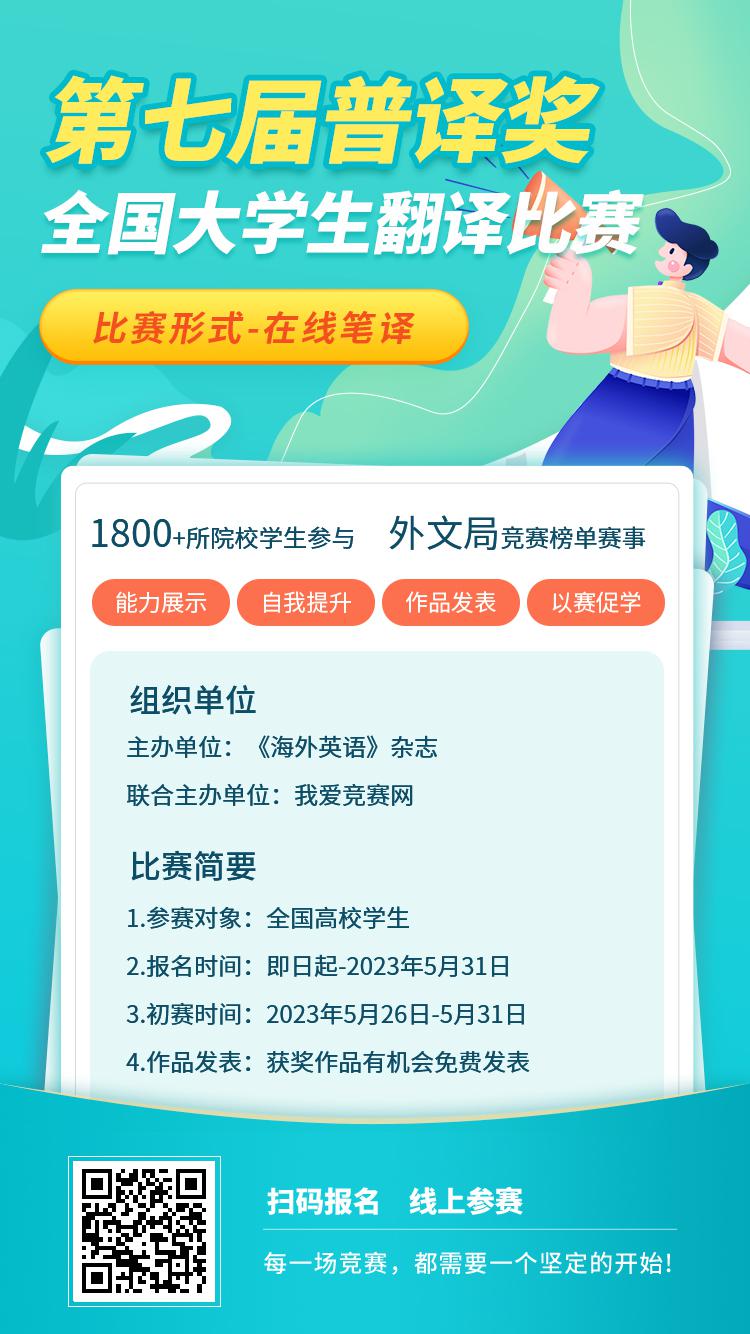(扫描下方海报二维码即可进入官网)

初赛题目 汉译英
大约在1500年前,中国发明了纸币。公元7世纪,唐代商人开始用纸制收据来结算,将金属硬币交予他人保管。到了10世纪,宋朝朝廷开始发行纸币。这一次,又是中国给世界带来了货币革新。中国在移动支付市场上发展迅猛,很可能会成为全球第一个建成“无现金社会”的国家。
中国在新经济和尖端技术上取得的成功让中国人有理由感到骄傲。中国的移动支付技术领先美国和欧洲,在迈向“无现金社会”的进展速度也超过西方多数发达经济体。中国消费者已习惯使用手机为小商品付款,支付宝和微信支付已经成为了中国创新的标志。
发展中国家的消费者和企业都希望实现无线金支付的情况下,手机二维码正在击败苹果支付和其他品牌的支付服务。中国为这种转型提供了一个有效的模式,而且很可能会被效仿。
移动支付等无现金支付方式在中国发展得如火如荼。它得益于三方面的发展,一是包括第三方支付在内的移动互联网技术的进步;二是年轻消费群体的移动支付习惯;三则与中国的城市化进程有关。城市人口相对密集,因此面对面的交易也相对多。在这个过程中,移动支付提供了很大的便利,同时这也有助于减少出现假钞的情况。
移动支付的兴起则大致经过了三个阶段。首先是通过扫描二维码来支付的方式改变了部分人的消费习惯。接着有越来越多的线下商家接受这种支付方式。再者是阿里巴巴和腾讯两大巨头在场景应用方面做了很多铺垫,包括购物,公共出行交通和水电煤支付等。
在很多领域,移动支付都产生了深刻的影响。最显著的是移动支付方便了居民的消费,无论是出门打车还是市场买菜都可以不带现金。在促进消费的同时,它还可以提高财产安全。有人开玩笑说,手机整天拿在手里的话,小偷也可能没钱可偷。此外,人们很多金融服务通过手机就可以实现了,去银行的需求也就越来越少,这对国内现有的金融行业,特别是银行业会产生深远的影响。
在世界范围内,中国移动支付的发展处于领先地位,其规模和程度都很大,比西方国家发展得更迅速、使用频次更多、深度更广。这其中既有历史原因也有自己的独特优势。
传统上,中国的金融服务发展得比较慢,很多人没有信用卡或者没能得到相关的金融或理财服务,移动支付就弥补了这部分人群的金融需求。发达国家则是由于借记卡和信用卡支付系统比较完善,在移动支付方面的需求就比较少。
对其他金融体系发展较为滞后的发展中国家来说,中国移动支付的发展具有一定借鉴性,其低成本和便利性可以惠及当地民众,刺激经济增长。但是它存在一定的门槛。中国在无线网络等基建设施方面的前期投入比较大,建设得也比较好,因此能支持人们这种消费和支付行为。另外,中国人的工作和生活节奏比较快,对便捷或效率就有比较大的追求。当然,移动支付也可能存在一定的问题和风险,例如移动支付的数据安全以及支付系统的稳定性需要引起足够的重视。
总体来说,移动支付等无现金支付是一个健康的趋势。展望未来,中国移动支付的发展有两个趋势。一是在无现金支付的过程中,人们对于移动互联技术的要求越来越高。二是会有越来越多的商家和商业环境会来使用这种支付方式,并从国内扩展到国外。在海外华人比较多的地方和一些旅游场所,会有越来越多的人使用支付宝和微信支付等支付方式。这也是推动中国移动互联技术在全球布局的过程。
初赛题目 英译汉
The Business of Planting Trees
A Growing Investment Opportunity
Approximately 41 million trees are cut down every day—far faster than we are currently replanting them. The consequences of deforestation and other types of land degradation are severe, exacerbating climate change, biodiversity loss, and declines in ecosystem services that hundreds of millions of people depend on.
In response, governments around the world have committed to restore 160 million hectares—an area larger than South Africa. But it will take more than government action to execute on these commitments; the private sector has an important role to play, too.
In fact, these commitments are spurring increased demand for companies that can deliver large projects cost-effectively—restoring degraded land has the potential to become a big business opportunity, on top of providing much needed climate mitigation and other ecosystem benefits. Established companies and entrepreneurs alike are finding new ways to make money from sustainably managed forests and farms.
Some are responding to governmental incentives; others are responding directly to the market, restoring land to generate new products and services, or to differentiate their offerings from the competition. Some entrepreneurs are betting that a huge new business opportunity for natural carbon capture and sequestration will emerge as more governments charge a fee for emissions driving climate change. New research by The Nature Conservancy, World Resources Institute and other partners shows that restoration and other land management improvements could provide more than a third of the emissions reductions necessary to keep global warming under 2°C.
Yet hurdles remain, and one of the biggest is funding. Many investors still know little about restoration opportunities. This report is intended to bridge that information gap; it includes case studies of 14 innovative enterprises across eight countries. They cover a fascinating range of activities, from drones that shoot seeds into hardened soils to genetic research on tree species threatened with extinction.
The restoration economy is at the take-off stage. New business models are emerging, technology is advancing and governments are showing political will. This is great news for investors looking for the next growth opportunity. And this is good news for the planet, since restoring land can provide clean water, improve livelihoods and enhance biodiversity—all while pulling back to the earth excess atmospheric carbon that would otherwise be heating the planet.
Opportunities have never been greater—and the task has never been more urgent. As an ancient Chinese proverb says, “The best time to plant a tree was 20 years ago. The next best time is now.”
决赛题目 汉译英
几千余年前,正是在丝绸之路上,西汉张骞两次从陆路出使西域,中国船队在海上远达印度和斯里兰卡;唐代对外通使交好的国家达70多个,来自各国的使臣、商人、留学生云集长安;15世纪初,航海家郑和七下西洋,到达东南亚诸多国家,远抵非洲东海岸肯尼亚,留下了中国同沿途各国人民友好交往的佳话。
几千余年后,正是在丝绸之路上,世界其他文明与中华文明交流互鉴。源自中国本土的儒学,早已走向世界,成为人类文明的一部分。佛教传入中国后,同儒家文化和道家文化融合发展,形成了具有中国特色的佛教文化和理论。中国的造纸术、火药、印刷术、指南针四大发明带动了整个世界的革故鼎新,直接推动了欧洲的文艺复兴。中国哲学、文学、医药、丝绸、瓷器、茶叶等传入西方,渗入西方民众日常生活之中。
在这种意义上,中国不仅仅只是一个国家或是民族国家,她更是一种文明,一种独特而深邃的文明。中华文明曾长期处于世界领先地位,是世界主流文化之一,对包括西方文化在内的其他地区文化曾产生过重要影响,排他性最小,包容性又最强,为整个世界克服困难、生生不息提供了强大精神支撑。
决赛题目 英译汉
What is an "Inclusive Green Economy"?
An Inclusive Green Economy (IGE) has evolved from earlier work on Green Economy. In its simplest expression, such an economy is low carbon, efficient and clean in production, but also inclusive in consumption and outcomes, based on sharing, circularity, collaboration, solidarity, resilience, opportunity, and interdependence. It is focused on expanding options and choices for national economies, using targeted and appropriate fiscal and social protection policies, and backed up by strong institutions that are specifically geared to safeguarding social and ecological floors. And it recognizes that there are many and diverse pathways to environmental sustainability.
Our approach speaks to the multiple benefits – economic, health, security, social and environmental – that such an approach can bring to nations, mindful of the different challenges faced by states along the development continuum, be they developed, developing, emerging, or in conflict. It argues for policies that are nuanced, context-dependent, and modulated. An integrated approach can help states understand how to maximize, prioritize, and sequence the different benefits to human well-being that can be derived from a healthy environment. At the end of the day, an inclusive green economy must provide not only for jobs and income, but for our health, our environment, and our future. This is our common challenge: creating the conditions for enhanced prosperity and growing social equity, within the contours of a finite and fragile planet.
An Inclusive Green Economy is an alternative to today's dominant economic model, which generates widespread environmental and health risks, encourages wasteful consumption and production, drives ecological and resource scarcities and results in inequality. It is an opportunity to advance both sustainability and social equity as functions of a stable and prosperous financial system within the contours of a finite and fragile planet.It is a pathway towards achieving the 2030 Agenda for Sustainable Development, eradicating poverty while safeguarding the ecological thresholds, which underpin human health, well-being, and development.
(责任编辑:jingsai) |